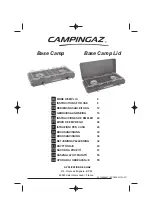
13
Installation Cont.
Gas Connection
The appliance’s gas inlet fitting is a 1/2” male threaded conic gas type in accordance with the ISO 7-1
standards.
• When making the gas connection Fig. 8, it is critical to place the gasket (Fig. 8, A) in between the inlet pipe
(Fig. 8, C) and the elbow (Fig. 8, B), to ensure a gastight seal.
• Ensure that you tighten the nut on the inlet pipe straight to avoid a gas leak.
• DO NOT USE TEFLON TAPE OR OTHER GAS THREAD SEALENT
Fig. 8
Fig. 8
A
B
C
For Natural Gas you need to install the regulator (Fig. 9) supplied with the appliance. The regulator has a test
point to enable an authorised licenced plumber/gasfitter to check for gas leaks after the cooktops installation.
Fig. 9
Fig. 10
For LPG no regulator is installed. Instead a brass test point fitting (Fig. 10) is fitted. The brass test point fitting
has a test point to enable an authorised licenced plumber/gasfitter to check for gas leaks after the cooktops
installation.
Converting from NG to LPG
Your gas cookcop comes configured for Natural Gas. If you live in an area where there is no Natural Gas then
your cooktop can be converted to LPG. Gas conversions can be carried out by an authorised and licenced
gasfitter/plumber.
WARNING:
Always isolate the cooktop from the electricity supply before changing the injectors and/or
adjusting the minimum flow of the burners.
SGCW75S
CT C
56582 04 2017










































